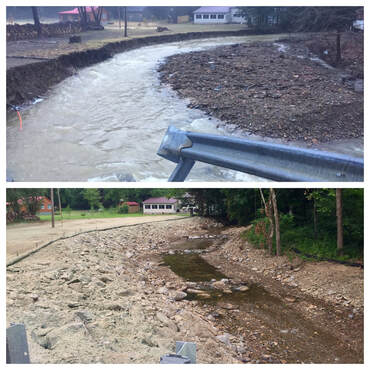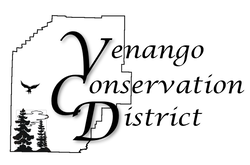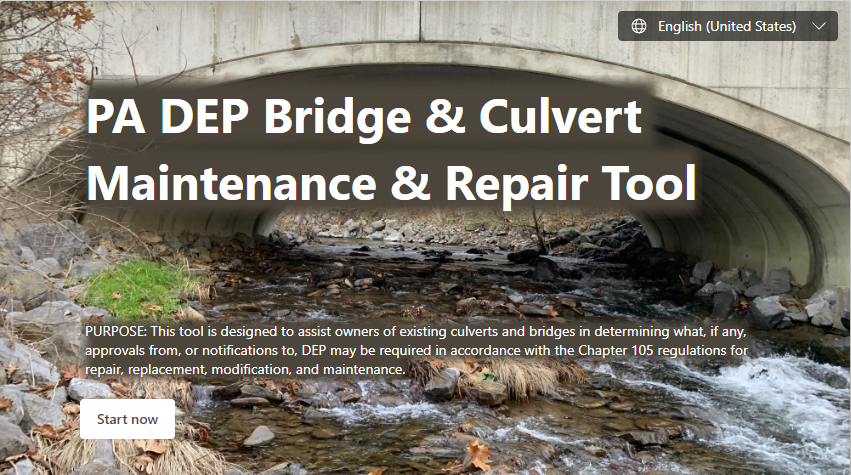Our Resource ConservationistOur Resource Conservationist administers the Chapter 105 Program in Venango County. Duties include reviewing general permits for activities that are considered encroachments or obstructions to a watercourse, floodway, or waterbody. For questions or to request technical assistance, please contact: Abigail Zerbe Resource Conservationist (814) 676-2832 ext. 3 [email protected] |
What are Water Obstructions & Encroachments An example of a stream restoration project that required permitting under the Chapter 105 regulations An example of a stream restoration project that required permitting under the Chapter 105 regulations
Earthmoving activities that will be taking place in a watercourse, floodway or waterbody, are regulated by Pennsylvania’s Chapter 105 regulations. These activities, in most cases, require the issuance of a general permit (GP). The Venango Conservation District has been delegated by the Department of Environmental Protection to administer the issuance of most general permits for Venango County.
Activities that change, expand, or diminish the course, current or cross section of a watercourse, floodway, or waterbody are termed encroachments or obstructions and are regulated activities. The purpose of the program is to protect public health, safety and the environment. Most projects in Pennsylvania’s waters and wetlands also require a federal authorization. That would be granted with the issuance of a PA Programmatic General Permit (PASPGP-4). This approval is attached by the DEP or conservation district along with the registered general permit. The PASPGP-4 eliminates the need for redundant federal reviews and processing for projects. |
Do You Need a Permit?
 DEP's "Guidelines for Maintaining Streams in Your Community" booklet is a valuable resource to determine the types of activities that require a Chapter 105 permit. Click on the image above to access the booklet.
DEP's "Guidelines for Maintaining Streams in Your Community" booklet is a valuable resource to determine the types of activities that require a Chapter 105 permit. Click on the image above to access the booklet.
The Chapter 105 program regulated activities and structures in or near regulated waters. This includes streams, bodies of water, or its adjacent floodway. A permit is required in most cases before starting activities that change, expand, or diminishes the course, current, or cross-section of a stream, floodway, or body of water. For example, a project involving excavation work that occurs in, along, or across a stream (even if the material is put back following completion) will usually require some type of Chapter 105 permit or authorization.
Regulated waters include any watercourses, streams, or bodies of water (ponds, lakes, and wetlands) and their floodways.
A regulated stream includes any channel or conveyance of surface water having defined bed and banks, whether natural or man-made, perennial, or intermittent. Even though some streams dry up in the summer, this definition includes those streams as well.
A floodway includes the channel of the stream and portions of the adjoining floodplain necessary to carry and discharge a 100 year frequency flood. Some municipalities have flood insurance studies and maps under the Federal Emergency Management Agency (FEMA) which indicate floodway boundaries for major rivers and some streams. In the absence of such a study, the floodway is considered to extend from the stream to 50 feet from the top of each streambank.
Regulated waters include any watercourses, streams, or bodies of water (ponds, lakes, and wetlands) and their floodways.
A regulated stream includes any channel or conveyance of surface water having defined bed and banks, whether natural or man-made, perennial, or intermittent. Even though some streams dry up in the summer, this definition includes those streams as well.
A floodway includes the channel of the stream and portions of the adjoining floodplain necessary to carry and discharge a 100 year frequency flood. Some municipalities have flood insurance studies and maps under the Federal Emergency Management Agency (FEMA) which indicate floodway boundaries for major rivers and some streams. In the absence of such a study, the floodway is considered to extend from the stream to 50 feet from the top of each streambank.
General PermitsThe following is a listing of Pennsylvania Department of Environmental Protect general permits. The Venango Conservation District is delegated to issue these permits with the exception of *GP11. Click the links associated with each permit to access the appropriate forms. Completed documents should be submitted to our office for review.
GP1 – Fish Habitat Enhancement Structures - forms GP2 – Small Docks and Boat Launching Ramps - forms GP3 – Bank Rehabilitation, Bank Protection and Gravel Bar Removal - forms GP4 – Intake and Outfall Structures - forms GP5 – Utility Line Stream Crossings - forms GP6 – Agricultural Crossings and Ramps - forms GP7 – Minor Road Crossings - forms GP8 – Temporary Road Crossings - forms GP9 – Agricultural Activities - forms GP10 – Abandoned Mine Reclamation - forms *GP11 – Maintenance, Testing, repair, Rehabilitation or Replacement of Water Obstructions and Encroachments - forms GP15 – Private Residential Construction in Wetlands - forms *For questions regarding maintenance, testing, repair, rehabilitation, or replacement of water obstructions and encroachments (general permit - 11) please contact the DEP Northwest Regional Office at 814-332-6945. |
Important FormsChapter 105 Permit Registration Form Use this form to register for the applicable permit you are applying for General Permit Application Forms Find information on DEP's resource library that contains permit application forms and instructions Chapter 105 Fee Calculation Worksheet Use this form to calculate fees associated with each permit type General Permit Transfer & Submerged Land License Agreement Form Used to properly complete the Chapter 105 permit transfer process. Pennsylvania Natural Diversity Index (PNDI) Website General permits require a PNDI receipt submitted with application materials |
Permit Assistance Tools
|
DEP’s Bridge and Culvert Maintenance & Repair Tool is an online interactive tool designed to assist bridge and culvert owners in determining what, if any, permit and notification requirements are needed for bridge and culvert maintenance and repair. By answering questions about the bridge and culvert, the nature of the proposed work, and to avoid delays the tool will direct you on how to move forward with your project.
|


